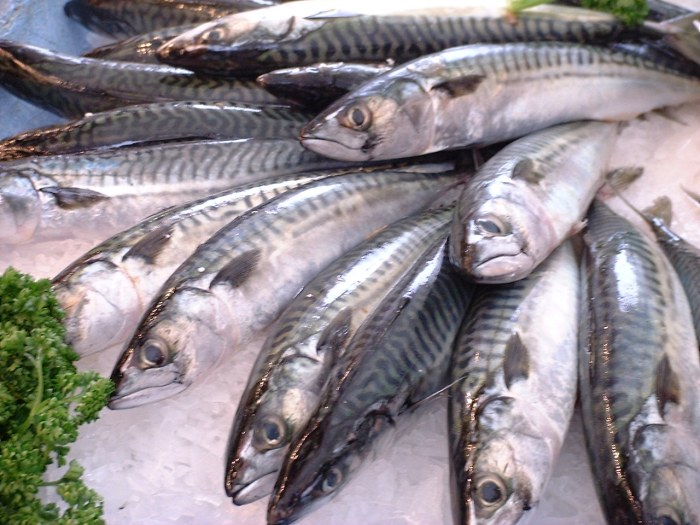Mackerel as food on:
[Wikipedia]
[Google]
[Amazon]

 __NOTOC__
__NOTOC__
 Mackerel is an important
Mackerel is an important
''The Cambridge economic history of Europe''
CUP Archive, pp. 166–168. . In Japan mackerel is commonly cured with salt and vinegar to make a type of
Handling and processing mackerel
Torry advisory note 66.
Mackerel nutrition facts
{{mackerel Scombridae Mackerels Oily fish Commercial fish

 __NOTOC__
__NOTOC__
 Mackerel is an important
Mackerel is an important food fish
Food is any substance consumed by an organism for nutritional support. Food is usually of plant, animal, or fungal origin, and contains essential nutrients, such as carbohydrates, fats, proteins, vitamins, or minerals. The substance is ing ...
that is consumed worldwide. As an oily fish
Oily fish are fish species with oil (fats) in soft tissues and in the coelomic cavity around the gut. Their fillets may contain up to 30% oil, although this figure varies both within and between species. Examples of oily fish include smal ...
, it is a rich source of omega-3 fatty acids
Omega−3 fatty acids, also called Omega-3 oils, ω−3 fatty acids or ''n''−3 fatty acids, are polyunsaturated fatty acids (PUFAs) characterized by the presence of a double bond, three atoms away from the terminal methyl group in their chem ...
. The flesh of mackerel spoils quickly, especially in the tropics, and can cause scombroid food poisoning. Accordingly, it should be eaten on the day of capture, unless properly refrigerated or cured.
Preservation
Mackerel preservation is not simple. Before the 19th-century development of canning and the widespread availability ofrefrigeration
The term refrigeration refers to the process of removing heat from an enclosed space or substance for the purpose of lowering the temperature.International Dictionary of Refrigeration, http://dictionary.iifiir.org/search.phpASHRAE Terminology, ht ...
, salting and smoking were the principal preservation methods available. Historically in England, this fish was not preserved, but was consumed only in its fresh form. However, spoilage was common, leading the authors of ''The Cambridge Economic History of Europe'' to remark: "There are more references to stinking mackerel in English literature than to any other fish!" In France mackerel was traditionally pickled with large amounts of salt, which allowed it to be sold widely across the country.Clapham JH, Postan MM and Rich EE (1941''The Cambridge economic history of Europe''
CUP Archive, pp. 166–168. . In Japan mackerel is commonly cured with salt and vinegar to make a type of
sushi
is a Japanese dish of prepared , usually with some sugar and salt, accompanied by a variety of , such as seafood, often raw, and vegetables. Styles of sushi and its presentation vary widely, but the one key ingredient is "sushi rice," also ...
known as saba-zushi. Historically saba-zushi originated in Kyoto
Kyoto (; Japanese language, Japanese: , ''Kyōto'' ), officially , is the capital city of Kyoto Prefecture in Japan. Located in the Kansai region on the island of Honshu, Kyoto forms a part of the Keihanshin, Keihanshin metropolitan area along wi ...
as a solution for transporting mackerel to the inland city, which otherwise would not have made the journey from the coast still fresh. The road linking Obama bay and Kyoto is now also called "mackerel road" (saba-kaido).
Popularity
For many years mackerel was regarded as unclean in the UK and elsewhere due to folklore which suggested that the fish fed on the corpses of dead sailors. A 1976 survey of housewives in Britain undertaken by theWhite Fish Authority
The Sea Fish Industry Authority (or Seafish) is a non-departmental public body in the United Kingdom sponsored by the Department for Environment, Food and Rural Affairs. Established in 1981, and charged with working with the UK seafood indus ...
indicated a reluctance to departing from buying the traditional staples of cod, haddock or salmon. Less than 10% of the surveys 1,931 respondents had ever bought mackerel and only 3% did so regularly. As a result of this trend many UK fishmongers during the 1970s did not display or even stock mackerel.
Mercury
There is a large variation in the mercury levels found in mackerel. These levels differ markedly for different species, and even for the same species in different locations; however, the strongest positive correlation seems to be connected to the species' size (the larger species being higher on the food chain). According to theUnited States Food and Drug Administration
The United States Food and Drug Administration (FDA or US FDA) is a federal agency of the Department of Health and Human Services. The FDA is responsible for protecting and promoting public health through the control and supervision of food s ...
, king mackerel
The king mackerel (''Scomberomorus cavalla'') or kingfish, is a migratory species of mackerel of the western Atlantic Ocean and Gulf of Mexico. It is an important species to both the commercial and recreational fishing industries.
Description
Th ...
is one of four fishes, along with swordfish, shark
Sharks are a group of elasmobranch fish characterized by a cartilaginous skeleton, five to seven gill slits on the sides of the head, and pectoral fins that are not fused to the head. Modern sharks are classified within the clade Selachi ...
, and tilefish
250px, Blue blanquillo, ''Malacanthus latovittatus''
Tilefishes are mostly small perciform marine fish comprising the family Malacanthidae. They are usually found in sandy areas, especially near coral reefs.
Commercial fisheries exist for th ...
, that children and pregnant women should avoid due to high levels of methylmercury found in these fish and the consequent risk of mercury poisoning.
Gallery
References
Citations
Sources
* Keay JN (2001Handling and processing mackerel
Torry advisory note 66.
External links
Mackerel nutrition facts
{{mackerel Scombridae Mackerels Oily fish Commercial fish